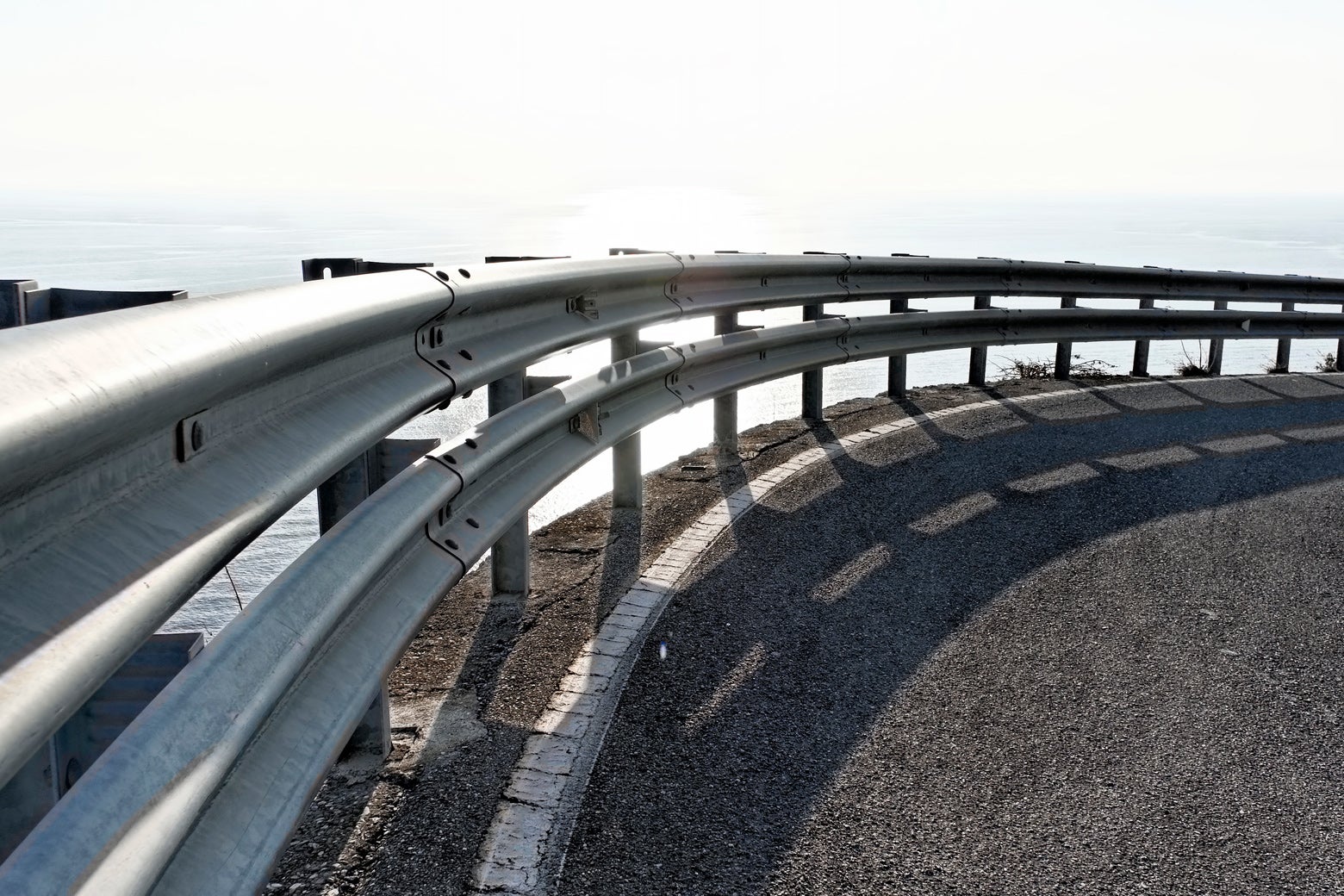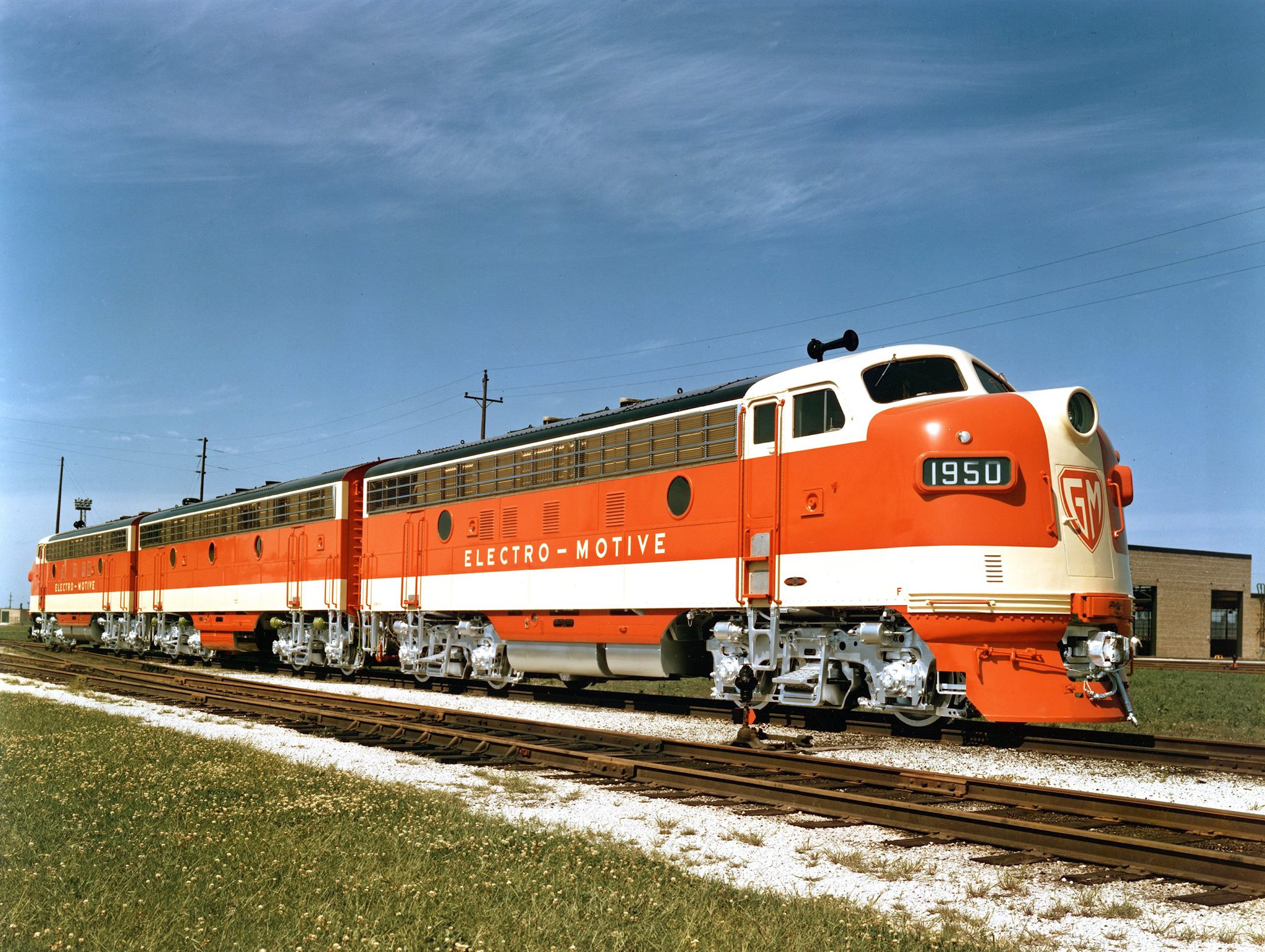Guardrails, much like the crumple zones of cars, are designed to give way to dissipate energy. This is a safety feature which saves lives. There isn’t going to be a one-size-fits-all-traffic guardrail. It’s about statistically improving outcomes, but unfortunately they aren’t going to help in all cases. Maybe they need to be updated, but it’s going to take time to adjust to changing average vehicle weights.
In a better world roads would be closed for cars which exceed the capacity of those guard rails. Just put up a sign, do some enforcement and people will start buying smaller cars when they can’t use them.
deleted by creator
What would we do about semi trucks, delivery vans, busses, dump trucks, etc. etc. etc. Personally I’ve seen some pretty short busses but never a sport compact model.
There are already road signs that limit vehicle weight or restrictions for these vehicles anyway.
Pretty much all of those vehicles require a CDL.
Seems like vehicles over a certain weight requiring a special license classification is a pretty straightforward and reasonable requirement.
But we can’t do it without simultaneously addressing mass transit, bikeped, and our general absolute psychological fixation around designing all of our society around cars first and people second.
Actually pretty much none of them require a CDL unless you’re operating commercially.
You can go buy a school bus right now and drive it around without a cdl. Only needed to carry passengers.
You don’t need a CDL to be a delivery van driver either at all.
The current GVWR limit before you need a CDL is 26,000lbs. No light duty vehicle on the road comes close to that. Even the biggest Ram 4500 caps out at 16,500lbs GVWR. The Hummer EV caps out at 10,550lbs.
Actually, you only need a CDL if you’re driving it commercially. I could walk out and buy a semi right now and drive it home. This is why you can rent Uhaul trucks and buy bus-sized RVs without a special license.
It varies somewhat by state, but that’s generally incorrect.
Because the type of vehicle, and not the driver, defines who needs a CDL, the following characteristics have been set forth to define what a commercial motor vehicle is. A CDL is required of any driver of:
- Any vehicle designed to carry 16 or more persons including the driver, such as our campuses’ mini buses.
- Any vehicle that weighs over 26,000 pounds (defined as the greater of manufacturer’s gross vehicle weight rating, manufacturer’s gross combination weight rating, actual weight, or registered weight).
- Any vehicle that carries hazardous materials that require placarding as found in Title 49, Code of Federal Regulations, Part 397.
These requirements include volunteers and temporary renters of such vehicles who are driving commercial motor vehicles on University business.
Uhaul intentionally goes right below the cutoff. Their largest truck is 26’:
https://www.uhaul.com/Truck-Rentals/26ft-Moving-Truck/
Which has a GVWR of 25,999lbs. Very precise of them and totally real.
I appreciate the correction
I did not know that, but it unfortunately makes sense. You should always be absolutely terrified for your life when you see a uhaul for a reason.
God, it truly is “for non-commercial use only”. I hear a chorus of sovcits cheering.
In an even better world, policies wouldn’t be manipulative shitstains aimed at consumers and instead be regulation on those actually creating the thing that needs to change…
Vehicles that weigh more than 4 tons make up a significant amount of road traffic right now.
Literally everything you purchase in a store, your food, your toiletries, your clothes, any consumer good you have every purchased traveled on a road at some point in a vehicle that far exceeds 8 tons. Ambulances weigh more than 8 tons, fire trucks weigh more than 8 tons, mail is transported in vehicles that weigh more than 8 tons.
7,000lbs is an extremely low failure point for a guard rail given the number of vehicles that exceed that weight on the road today.It failing against a semi or a firetruck is kind of understandable but…yeah. Ambulances and then the ‘smaller’ every day vehicles? this shit is unacceptable
Require a CDL for the big vehicles. Maintain stringent requirements for the CDL.
Do you still want that electric Ram?
A good chunk of what’s mentioned in GP already requires a CDL. That’s not the issue.
I keep seeing “CDL” brought up as a magic solution, and it’s clear people haven’t looked into how it works and what it affects.
Commercial driver’s license? I AM TRAVELLING AND NOT ENGAGED IN COMMERCE
Oh, that brings back some memories of Reddit
I DEMAND TO BE ABLE TO DRIVE MY 18 WHEELER WHEREVER I PLEASE, HEIGHT CLEARANCES ARE A DEEP STATE PLOT TO TAKE AWAY MY FREEDUMB
11’8" bridge cares not for your “freedoms”
But he noted that in the real world, a guardrail is much more likely to be placed next to a steep [drop-off] than a concrete barrier.
Thankfully it was a test, but there’s probably already instances where an over-weight vehicle has smashed through safety devices.
I’m willing to bet the super tall pickups and SUVs are more likely to hop over those steel guardrails, too. Related: Those sloped concrete dividers that have a slightly shallower slope at their wider bottom? Those are super effective, because that bottom slope deflects the vehicle’s front wheel, causing it to turn slightly away from the barrier instead of continuing to smash through it.
It’s called a Jersey barrier.
They have other issues though. They cost more to produce, cost more to install and cost more to maintain. They also accumulate snow, which would otherwise blow through an open W guard rail.
A third option are wire guards. They’re cheaper on all accounts, don’t get tagged with graffiti and statistically save more lifes. They work best on long straight stretches, but because of the flexibility, they are not ideal for inner city streets where it’s best to avoid any lane breaches at all.
Wire guards are wildly unsafe for motorcyclists though.
That’s a myth. It may look like a “cheese grater” but statistics show that they have saved more motorcycle lifes than any other barriers, and there are no records of anyone actually getting grated.
I hate to be the “sources” guy, but the last time I looked at what few studies there where on the topic they weren’t positive. Could you direct me to where you found that info?
Everything is wildly unsafe for motorcycles though.
Those are called jersey barriers
There’s a guard rail guy on YouTube who investigates how the guard rails have been fitted. They often have bolts and the tension wire incorrectly installed so much so that they don’t even effectively stop small vehicles. That guy lost a family member to this type of accident and so is on a crusade kinda.
My kinda superhero
https://m.youtube.com/@TheGuardrailGuy
It’s sad because you can hear the frustration in his voice that for the sake of better training lives could be saved.
I am contracted to a utility and I get to see just how much time they spend on teaching people about safety. We still see deaths and serious injuries because some people are so lazy they don’t give a fuck if they kill someone.
The current version of MGS was developed to withstand cars weighing a maximum of 5,000 pounds, but many of today’s SUVs and trucks exceed that threshold.
MGS being what I’ve known as W beam guardrail.
Fun fact: In Spanish it’s called ‘quitamiedos’, which literally means ‘fear remover’. It’s not supposed to stop you, just let you drive closer to the edge :)
I know America has an obesity epidemic, but did it really have to be extended to our cars?
fuel eff requirements tied to weight
just another oil company + car company scam
The car companies (like basically all other corporations) successfully passed their externalities onto the Government and the Government has done nothing to try to recoup those costs.
Sounds like a you problem -Car Ceo’s
It’s not like heavy work trucks didn’t exist back then, was it just that there weren’t enough of them to care?
NGL - my last car was pretty big, but Google assures me it was only 4,100 lbs. My current car is the same size and is just under 5,000 pounds.
Yeah, it’s about reducing fatalities by engineering to the average, not engineering to the worst case.
If you mean pickup trucks they have massively increased in size and weight.
If you mean tractor trailers there’s little stopping that.
I mean, my grand dad’s GMC from the 70s wasn’t SIGNIFICANTLY different from your F-150s today.
This looks about right… bench seats, no seatbelts, ashtray… yee haw!
https://www.streetsideclassics.com/vehicles/7277-cha/1972-gmc-c1500-sierra-super-custom
Have you seen the size of F150s today?
209-244″ L x 80-87″ W x 75-80″ H
Compared with the '72 GMC
207.75" L x 79" W x 70" H?
2-3 feet longer, 8" wider (the hardest one to change and they still did it), and nearly a foot taller. Thank you for proving my point. We can also add hood height has gone up.
EVs are extremely heavy too.
Yes, as mentioned in the article they can be 30% heavier for the same vehicle
Electric cars often weigh around 30 percent more than a gas-powered counterpart, because big vehicles require enormous batteries to propel them hundreds of miles between charges.
Yes but the sedans still come in under the guard rail safety limit.
Sure, so will bikes… The concern is that the infrastructure is unsafe for a good portion of current and future vehicles on the road. Say what you will about people buying vehicles that are too big for their needs, they still deserve safety never mind all of the people with legitimate needs for those vehicles.
They sure do deserve safety, So we should make sure the vehicles they can buy are safe. Upgrading the entire country’s safety infrastructure for the ego of pickup and full size SUV drivers is not acceptable.
And those who have legitimate needs for those vehicles deserve to die?
Not very many people have a legitimate need. And if you want to upgrade safety to the point it would stop a Semi/Box truck then you’re spending way too much money. That’s why those vehicles require a special license to operate. It would be more feasible to put in massive amounts of light rail freight if you’re that worried about safety. Also, work vans are a thing in 90% of the world.
Ok now you have to be trolling… Work vans are like 9000lbs
Yes, but they wouldn’t have to be, if not for people wanting a giant SUV with 400 miles of range. The weight goes up nonlinearly, because people aren’t willing to compromise on lifestyle for the benefit of those around them. And then they expect us not just to tolerate their lifestyle, but actually subsidize it.
Without them necessarily being SUVs, in North America, distances between cities or municipalities are pretty big. Such a trip would be 2 hours in Europe, but in North America it can easily go up to 5 hours or more.
Either we find a way to charge a car in 2 minutes, or find an alternative, otherwise we need big batteries and they will inevitably increase the weight of the car.
I regularly drive 6 hours to see family. I wish there were reliable chargers partway. I don’t think they’d have to be 2 minutes. 40-50 minutes and near restaurants would be fine for me. Most importantly, they have to have similar uptime to a gas station. Eg, the current out-of-order rate for Chargepoint, Blink and other non-Tesla charging networks is far too low in my experience to rely on for long distance drives. Too high a risk of being stranded.
I’m in Texas and will have to pay a $300 registration tax on my ev for it being “heavy and destructive and not paying fuel tax”. My ev is a 2018 Fiat 500e and weighs 2900lbs. I’m tired of this argument especially when plenty of trucks weigh anywhere from 4500lbs (for the smallest examples) to quite literally 80k. Raise the fuel tax and you’ll solve heavy vehicles virtually overnight.
Before anyone gets on my case I’m fully aware that not all evs are as light as mine, but plenty are lighter than an f150.
It’s an interesting problem. We want people to ideally just drive less, and use EVs when they do, but EVs are heavier for the same vehicle and don’t buy fuel that’s usually taxed to help cover vehicle infrastructure costs. So they can cause extra wear and don’t pay for it. I’m not sure how to solve that future problem other than tolls maybe?
Same way we can fund everything else: tax the rich, cut mitary spending.
That doesn’t solve the issue though… We want to tie driving more to paying more.
Right now, fuel taxes work decently well as heavier vehicles tend to burn more and the more you drive the more fuel you need too. EVs don’t operate the same way, and we don’t want electricity in general more expensive to cover roads as that doesn’t encourage people to drive less.
“We want to tie driving more to paying more.”
Why? Because it’s fair? I don’t really give a shit if it’s fair, we need functioning infrastructure and incentivizing people to pay less into that system is counterproductive.
Being expensive demonstrably does not reduce driving in any significant way. The near-total lack of functional alternatives needs to be addressed.
They won’t stay that way forever. Our battery tech is far from hitting theoretical limits of kwh per kg.
None of which will matter if all you can buy is big SUVs.
The sedans aren’t that heavy though. They’re under the 5,000lb limit
new vehicle weight tax to fund the new guardrails
Tax the heavy cars much more, they cause more dammage in crashes and way more wear and tear in general.
Fuck that. The problem isnt that people want bigger cars. The problem is that NHTSA’s CAFE standards favor manufacture of larger cars.
CAFE slowly reduces the amount of emissions that vehicles can have, but they fucked it up: the required reductions are greatest on the smallest, most efficient cars, and lowest on the largest vehicles. Manufacturers “comply” with these standards by dropping their smallest cars from their lineup, and increasing the sizes of everything left on the market.
Fix the fucking standards to favor smaller cars, and manufacturers will follow.
I don’t see how that’s a better solution than taxing heavier cars…? We can tax the sales of the vehicle directly which negatively impacts manufacturers because in the USA each vehicle dealership is brand associated rather than retailers.
For a tax to be effective for such a purpose, it has to be avoidable. They have to actually make a small car. But the CAFE standards as they currently stand prevent them from cheaply producing a CAFE compliant small car. So nobody gets the tax break on the small car, because there are no small cars to be had.
The tax approach cannot be achieved until the CAFE standards are fixed, but once we fix the CAFE standards to favor smaller cars, the problem solves itself.
CAFE works by requiring a certain percentage of the total number of a manufacturer’s vehicles to comply. Small cars are currently non-compliant. Only big cars are compliant, so they need to sell more of them. When we correct CAFE standards to favor small cars, they will need to sell small cars, and their marketing departments will get to work at adjusting consumer demand.
If it’s cheaper to produce a small car because of the tax, then the tax is effective. Making the bigger cars more expensive incentivizes the smaller cars.
Taxes, fines, and regulatory fees in economic theory are supposed to represent the costs incurred by the general public (in this case the environment as well as infrastructure maintenance) being paid by the parties responsible. This often is not the case in practicality, such as the costs to reverse methane emissions not being covered by the fines associated with flare stacks.
If the companies can’t produce cars cheap enough then they’ll have to raise the price. If less people can afford cars, that’s fine, then more investment will have to be made into public transport, bike lanes, and walkable communities. I do not see any downsides to a tax on larger vehicles.
If it’s cheaper to produce a small car because of the tax, then the tax is effective.
It is not cheaper to produce the small car. You’re not quite understanding this.
The small car does not comply with the perverse CAFE standards. The big cars do comply. If they sell too many of the efficient, but non-compliant small cars, they get penalized. That penalty greatly increases the cost of producing the small, non-compliant car.
Without CAFE standards, your argument is reasonable and valid. With the asinine standards currently in place, your argument is completely irrelevant.
It is not cheaper to produce the small car. You’re not quite understanding this.
The small car does not comply with the perverse CAFE standards. The big cars do comply. If they sell too many of the efficient, but non-compliant small cars, they get penalized. That penalty greatly increases the cost of producing the small, non-compliant car.
Do not sit there and tell me that it’s impossible for a small car to comply with standards. That’s ridiculous. Charge them extra for selling a big car so that making a big car is more expensive than creating a small car. You can’t just say that this is impossible and deny the obvious solution, this is the clear solution.
Do not sit there and tell me that it’s impossible for a small car to comply with standards.
Clearly, you do not understand the problem with how CAFE standards are currently implemented, because that is, indeed, the case. The mandated reductions on small cars are too much, and the mandated reductions on large cars are not enough. Manufacturers did the math, and the most feasible solution was to increase the size of cars. Cars are proportionally wider now than they used to be, to maximize their footprint and bump them up into larger classes.
Manufacturers will do anything they need to to avoid violating CAFE standards. With current regulations, that means “sell fewer small cars”. If we try to solve the problem with taxes on large cars, manufacturers will simply increase the MSRP of small cars. Add a $5000 tax on large cars, and they will add $5000 to the sticker price on small cars, or otherwise ensuring the large car remains the better value.
Correct the regulations so that smaller, intrinsically efficient cars are feasible, while forcing manufacturers to go to extraordinary efforts to continue manufacturing large cars, and the problem solves itself.
It would be great if the standards could be loosened a bit to allow more sedans to exist. A modern crown vic would be awesome, but it’s impossible to make with the current rules.
I’d like a new, S10-sized truck, or even smaller, perhaps closer to a Japanese Kei truck. The current crop of “compact” pickups are larger than the “full size” trucks from the 1990’s.
Isn’t it great that we have to make every single regulation perfect without any possible loopholes because it’s just accepted fact that corporations will spend absurd sums of money to avoid having to do anything that might cut into their profit margins?
Awesome stuff.
This isn’t a loophole. This isn’t an example of inadequate pedantry. It’s not even an example of regulatory capture or corruption. This is straight up incompetence on the part of the regulators. They established an easy to meet standard, and a difficult to meet standard, and they went all Pikachu-face when the regulated manufacturers opted for the easier option.
Regulatory Incompetence like this (and malfeasance, like on the part of Ajit Pai’s FCC) are why Chevron Deference needs to be severely modified. We should be allowed to sue the NHTSA for this egregious a failure.
We should be allowed to sue the NHTSA for this egregious a failure.
Can you not? Are you sure? Honest question. It seems wrong to me, but if you have evidence that’s true…
Federal regulatory agencies seemingly get sued all of the time. It’s literally the basis for the current case regarding Chevron deference. There are other cases where the Justice Department is a party to the case.
It’s not incompetence, it’s just the inability to make regulations that are 100% bullet proof, it’s impossible because people are very creative. There is a constant conflict occurring between the regulators doing the best they can to create regulations that can’t be rendered useless, and greedy, amoral corporations that are doing everything in their power to worm their way through a crack and come up with some (often expensive), convoluted way to render the regulation null.
It’s like how DRM in video games kept changing and “improving,” because no matter how secure they were sure they made it, there was always some ridiculously intelligent teenager that comes up with a creative, novel way to crack it.
It’s an arms race, and said corporations will keep finding workarounds until the amount it costs to dodge a regulation becomes higher than what they would have lost had they just followed the rule in the first place… And even then I’m not sure.
I hate that Americans are so ignorant that we have to re-learn, the hard way, step-by-step as to why regulations that we already have exist. It would almost be funny if it didn’t mean that people have to die unnecessarily before they learn the same exact lesson that we already figured out (the hard way).
Can you not? Are you sure? Honest question. It seems wrong to me, but if you have evidence that’s true…
You can sue anyone at any time and for any reason, but that doesn’t mean you’ll prevail. Chevron Deference basically says that unless the agency is actually violating legislation, the courts must defer to the agency’s expertise. Even if the agency’s rule is counterproductive (NHTSA’s CAFE standards) or overtly hostile to the public interest (FCC overturning Net Neutrality under Ajit Pai’s leadership), the courts can only rule against them on the basis that they are violating legislated law.
Or just ban them from certain roads.
At least here in Cali we do. My HD truck gets an extra $500~ a year tax on top of the Gas guzzler tax I paid when new. Plus the fuel costs/taxes for that. Compared to my other cars I pay about $600 more for newal on it. The Average car is like $245 a year but the truck is like $840.
Definitely fine with paying the extra taxes though. I use more infrastructure and I also require additional strengthening of crash systems and cause road damage so I’m not opposed.
Meanwhile in Wisconsin I have to pay an extra $100/yr for registration because I drive a hybrid.
Why?
Because, I shit you not, driving a hybrid apparently costs the state too much money, because we have to fuel up less, and so they get less tax.
What the fuck.
Beats my state which passed a DC fast charge tax of nearly $3 per kwh while suspending gas taxes.
$120 in taxes per charge for a fairly normal EV. Yay.
Lol what state is doing this? That should basically kill EV sales there while simultaneously bringing their gas tax revenue to literally zero. Terrible financial choice.
Almost like it’s an ideological thing and not based on any kind of evidence or fiscal policy.
I kindaaaa get it from the states side. The problem they’re suffering from is just shitty taxes though. Rather than taxing gas they should be taxing based on vehicles and potential infrastructure usage. Given PHEV/BEVs don’t use gas they don’t pay as much into the system for roads. Since most roads are funded through fuel taxes. Which is clearly not going to work. I’d love a system rework of registration and gas taxes to solve this as we go into an electric future.
That said, here in Cali no one is also having a conversation about smog check stations that are state mandated on gas vehicles, but soon they could be a thing of the past and I worry about the economics of keeping smog stations alive when most cars don’t “pollute” the same way anymore.
Oooor. We already pay taxes for the roads, why is there a fuel tax at all. It’s like airline fees. They charge you up front for the flight, then have fees for all sorts of things. Only with taxes, each tax cost a significant amount to collect. One central tax for everything would save a lot of money. But of course somewhere there is a director of fuel taxes bringing home a couple hundred k a year…
We don’t properly pay taxes for roads. Like at all. We have a shit load of roads in the US and the maintenance is insane on them. Me paying my measly $900 a year in registration for my truck isn’t enough for the cost of roads, vehicle certifications, bridges, gas subsidies, tunnels, cleaning, water purification due to run-off, and thousands of other things that cars cause. Americans (me included) have the real cost of a driving centric country hidden from us and we act like taxing it appropriately is insane rather than realizing we chose the most inefficient method of transportation. A central tax doesn’t make sense because a lot of people in New York (as an example) don’t drive. Why should they pay for additional upkeep on roads they don’t actively use? They need bike lanes, walk ways, and subway infrastructure. Taxing vehicles at registration makes more sense. The idea behind the gas tax was that for people who drive more, and therefore use more infrastructure, they would pay more. It was designed to be fair and spread the cost evenly, but that’s clearly becoming a problem. Now we’re learning what that cost actually feels like and it sucks because we’re stuck with the bad decisions of our parents and grandparents.
How do you define makes more sense. Less types of tax mean less overhead. So the people get more for thier dollar. Who uses what doesn’t matter. I don’t use welfare, so should I not have to pay for it? I may not use the roads much, but the people who do are usually doing it for work, and one way or another that benefits me. So we should all just pay for everything that makes society work, and stop wasting so much on overhead.
If only everyone was as reasonable as you!
Rather than tax them a bit more, which won’t actually improve safety if people just opt to pay the tax and drive them anyway, why not just straight up legislate weight limits for private vehicles, with commercial licensing as done with cargo trucks expanded to fit more conventional vehicles driven for commercial purposes that have to be large and heavy? Car companies will start making smaller cars again real quick if they’re not allowed to sell them otherwise
The point is to use the tax to pay for upgrading the infrastucture. Also attempting to regulate car sizes like that would be political suicide in most states.
Why not make it a two peonged attack against heavy vehicles?
Tax heavy cars severely, and bring the smaller cars we have in Europe to the US, getting the VW Transporter and MB Sprinter would offer smaller, lighter and cheaper utility vehicles with more useful features to the US.
Why not make it a two peonged attack against heavy vehicles?
If we correct the perverse CAFE standards that push manufacturers to increase the size of their cars, the problem largely solves itself, without pissing off consumers.
The standards currently require proportionally greater decreases in emissions on smaller vehicles than larger vehicles. Manufacturers are deliberately increasing the sizes of their vehicles to qualify for the easier standards.
Requiring smaller decreases on smaller vehicles will reverse this trend. Manufacturers will need to spend considerable resources on R&D to improve the economy of larger vehicles, or slim them up so they qualify for a smaller category.
Velomobiles weight 35kg (77 pounds) and offer very good protection compared to normal bicycles. Theoretically you could design single seat cars not much heavier. Of course for higher speeds you’d want more protection and a little bit wider.
I imagine the ideal self driving car or robo-taxi to be two seats that face each other, so when you get one alone you have plenty of space to stretch your feet or put your groceries. It could be totally luxurious, simple to call and use and fast too. And the embodied energy would be very small and the “mpg” would be insane.
It’s just sad how badly we are tackling climate change by just letting the free market run wild.
I wouldn’t say that it’s a free market when there are so many mega corporations and their lobbies in government, but I agree with the rest
Yeah. For example everyone thinks patents are great because they reward the little inventor for having the great idea. But they become commodities that can be acquired with capital and create hindrances to the free market. Effectively they protect large capital investments to prevent disruptions to change the market too quickly. Anything new takes 20 years at least to be fully utilized.
With climate change that basically means every single improvement to turn our thousands of industrial process towards sustainability or circular economy is being min-maxed for profit.
There is no “free market”. It’s only an ideology, one that is actively being used to justify creating the conditions of megacorps and legal brides.
I’d be afraid of a world where brides were illegal.
(Just a joke mate, reread the end of your comment - you clearly meant bribes, but wrote brides.)
For the trucks and land boats that weight more. Lol, that’s is all.
The article literally says that the problem will just get worse as we move to electric cars since they’re heavier.
I dislike people having useless pickup trucks as much as the next guy, but I don’t think they deserve to die either. Or how about semi drivers? You know, a crucial part of our delivery infrastructure?
Maybe take the time to read next time and think with the smart part of your brain.
Yes, have you looked at the weights of actual electric cars and not electric SUV and trucks? The average weight of a electric car is between 3-6k in weight. Secondly, where was the outrage when people were complaining about semis and safety? NHTSA has been at the mercy of the semi industry regarding safety updates. How long have people been fighting regarding undercarriage protectors to protect car drivers from losing their lives to the semi industry? Where has the outage been about the weight protection of those guardrails for semis? I didn’t know semis are so new to this country.
Again, SUVs and trucks drivers that just drive those for status… Boofuckinhoo.
Here a link for your average weight for electric cars.
Even a Tesla weighs less than the max weight allowed for the rails. But I guess my brain is useless.
Edit: a whole documentary for you about the undercarriage guards link.
-
If the average of an electric car is 3-6k that means that is it sometimes above the 5,000 limit, am I wrong?
-
You just did a whataboutism with this undercarriage thing which is irrelevant
-
Yes, let’s send the pickup truck drivers to their death and do a fake sob about it, yeah? You feel good about that?
-
Electric cars are not going to stay that heavy. There are plenty of battery advancements in the pipe to bring that down. There also isn’t much reason to push range much over 400mi, and even that’s probably unnecessary.
Hmm, these huge trucks are killing pedestrians, causing worse crashes due to crash incompatibility, destroying the climate, and now smashing through guard rails and flying off cliffs. We’d better change our entire country’s infrastructure to accommodate them.
It’s the good Christian thing to do
Amen
Lol you apparently didn’t read the article… it’s calling out EVs because they’re usually heavier than the ICE counterparts. Small sedans are pushing 5k pounds now being EVs. Batteries are very very heavy.
It’s worth highlighting that this study isn’t really about the merits of EVs. After all, you can buy an EV that weighs less than 5,000 pounds. You just can’t electrify your favorite already-large car—or even buy a hulking gas-powered car—and expect guardrails to work as intended. “Weight is a universal problem; it is not unique to electric vehicles,” Stolle said. “We have similar concerns about the compatibility of the biggest gas-powered cars with our guardrail system.” The 6,700-pound Chevrolet Silverado 1500 already weighs too much, based on the result from this research, and the 8,500-pound Silverado EV weighs even more.
Yes but you called out trucks like they’re the only issue. An electric leaf is almost 5k pounds…a leaf…
I’m not the other guy.
A leaf is 3500-3900 lbs, not almost 5k lbs
Well if you
squint at thatround to the nearest 5k ¯\_( ͡° ͜ʖ ͡°)_/¯Curb weight on them is 4,900, yes it’s not 5k that’s why I said nearly 5k…and the point I am making is that a tiny car like that weighing that much shows that batteries are not light.
You added an extra 1000 lbs to the heaviest version, then rounded up. The whole entire point of standard weights is so numbskulls don’t just make up numbers for how much things weigh, like you are. The leaf is 350-3900 lbs, not 4900 lbs, not 5000 lbs. Please go back to elementary school.
https://www.autoblog.com/buy/2022-Nissan-LEAF-S__4dr_Hatchback/specs/
Should have clarified that I meant gross weight.
It doesn’t help that the first EVs most manufacturers are focusing on are their large SUVs and trucks. The Chevy Bolt and Tesla Model 3 both certainly aren’t small cars in a general sense, but in the land of EVs they are. Both weigh under 4000 pounds which is less than the best selling vehicle in North America, the F150.
Totally agree, but to act like it’s only trucks pushing this weight is silly. The electric leaf is nearly 5k lbs and it’s a very small EV.
There’s a big difference between pushing the limit and significantly exceeding the limit though.
One gets you across the bridge. One gets you a nice dip in the river.
The 2024 leaf is 3509lbs according to the Nissan USA website.
3500-3900 depends on what you get for options. Add in people and their shit and you’re pushing 5k (curb weight is 4,900bs)
You keep misusing the term curb weight.
From teh googs: Curb weight is the weight of the vehicle including a full tank of fuel and all standard equipment. It does not include the weight of any passengers, cargo, or optional equipment.
If that’s the fact then it absolutely is 4k+
Isn’t this just the road trying to solve the problem for us? I say we should have more ditches and guardrail barriers!
Maybe car sales taxes should scale by vehicle weight.
If you consume more of the road, you pay more
In the Netherlands you pay a road tax every 3 months. The amount is based on weight (because a heavier car does more damage to a road) but also on eco label. So an electric car that has the best eco label can have less tax than an old (but much lighter) diesel car.
Should the same approach be taken for the obese?
yes
Why is your font so tiny?
i dont know
help
ⁿᵒᵒᵒᵒᵒᵒᵒᵒᵒᵒᵒᵒᵒ
Ey tried to write it with ^ on both sides to indicate agreement to a comment right upwards, like this: ^yes^
But an unescaped circumflex makes the following upper script, so ^yes^ becomes yes
nice
deleted by creator
If they weigh enough to change a car’s impact on the road then…maybe?
An extra 30-60 lbs is only like +1% to the weight of the whole vehicle though. You could get a larger swing by just filling up the tank in a gas/diesel car.
I’m not sure that person meant that the obese should be made to pay more in automobile taxes specifically, but rather in health insurance premiums, or some other kind of
fatexcise tax.I’m of the opinion that, assuming that a licensed medical provider has performed an appropriate evaluation that excludes the diagnosis of an underlying metabolic disorder that specifically causes one to be obese, there should be remuneration made to the health system for the consequences rendered by their behavioral decisions.
Theres already precedent for this with tobacco use.
I do agree with the spirit behind that on some level, but it seems impossible in practice. Obesity, specifically the modern “obesity epidemic” is a complex systemic issue that involves government as well as industry.
They fundamentally do through taxes on emissions and fuel efficiency, plus fuel consumption taxes.
It’s just written as explicitly as it being a weight tax
they do. or more appropriately the registration fees.
That’s at least 500 stone.
Over $8800
Or like 1500 bricks.























